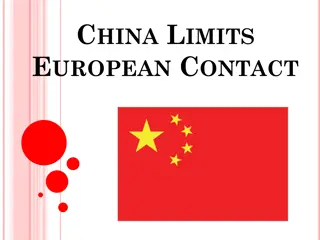America's Entry into World War I: Causes and Impacts
World War I and the 1920s witnessed America's transition from neutrality to active involvement in the war. Factors such as nationalism, militarism, imperialism, and alliances led to the conflict. The impact of technological innovations resulted in stalemate on the Western Front, leading to significa
0 views • 11 slides
Evolution of American Immigration Attitudes: 1918-1968
Attitudes towards immigration in the USA underwent significant shifts between 1918-1968 due to factors like isolationism, fear of revolution, prejudice, racism, social fears, and economic concerns. The influx of new immigrants from eastern and southern Europe challenged traditional American norms, l
1 views • 27 slides
Japan's Transformation During the Age of Imperialism
Japan's journey during the Age of Imperialism saw it transition from isolationism to becoming an imperial power. From strict order under the Tokugawa shoguns to the Meiji Era's rapid modernization, Japan adopted Western influences to reform and militarize. The Treaty of Kanagawa in 1854 marked the e
1 views • 20 slides
America's Involvement in World War II: A Comprehensive Overview
Americans in the 1930s grappled with the rise of fascism and totalitarianism in Europe while striving to maintain isolationism. Events such as the Panay Incident and the Lend-Lease Act eventually drew the U.S. into WWII, shaping views on freedom, mobilization, and the homefront, including changes in
1 views • 12 slides
Understanding Foreign Policy: The First Five US Presidents
Foreign policy is crucial in how a government interacts with other countries. The first five US Presidents - George Washington, John Adams, Thomas Jefferson, James Madison, and James Monroe - faced challenges in determining the country's foreign policy, dealing with issues like neutrality, isolation
0 views • 28 slides
Exploring China's Dynasties and Cultural Contributions
Ming Dynasty marked by agricultural reforms, Confucian revival, and Zheng He's voyages; Qing Dynasty's rule following Manchu invasion with emphasis on Confucian beliefs and economic reforms; Chinese inventions and zodiac as part of rich cultural heritage. Policy of isolationism led to limited Europe
0 views • 15 slides
America in the 1920s: Post-WWI Adjustments and Challenges
America faced significant adjustments and challenges in the immediate post-World War I period of 1919-1921. The country grappled with issues like disillusionment with foreign affairs leading to isolationism, economic recession due to returning soldiers and reduced demand for war supplies, the rise o
0 views • 12 slides
Exploring the 1920s: Unit 7 & Unit 8 Classroom Activities and Homework Overview
Dive into the dynamic era of the 1920s with engaging classroom activities like grading Unit 7 tests, vocab flip cards, reviewing the Roaring 20s, and checking understanding through Plickers. Explore topics like Nativism, Isolationism, Fear of Communism, and more. Complete assigned readings, finish p
0 views • 22 slides
The Roaring Twenties: Politics and Social Issues in 1920s America
The 1920s in America marked a period of significant political and social change. The nation saw a return to conservatism and isolationism after World War I, with the Republican Party in control. Nativism was on the rise, leading to restrictive immigration laws and controversial events like the Sacco
0 views • 22 slides
America as a World Power - Chapter 7 Summary
America transitioned from isolationism to becoming a world power by gaining territories like Hawaii, engaging in trade with Japan and China, and implementing the Open Door Policy in China. The end of isolationism led to imperialism, with the acquisition of Alaska, Hawaii, and expanding trade interes
0 views • 17 slides









